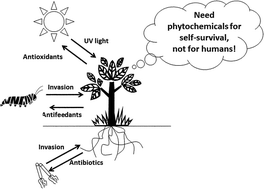Target molecules of food phytochemicals: Food science bound for the next dimension
Abstract
Phytochemicals are generally defined as

* Corresponding authors
a
Division of Food Science and Biotechnology, Graduate School of Agriculture, Kyoto University, Kyoto, JAPAN
E-mail:
cancer@kais.kyoto-u.ac.jp
Fax: +81-75-753-6284
Tel: +81-75-753-6282
Phytochemicals are generally defined as

 Please wait while we load your content...
Something went wrong. Try again?
Please wait while we load your content...
Something went wrong. Try again?
A. Murakami and K. Ohnishi, Food Funct., 2012, 3, 462 DOI: 10.1039/C2FO10274A
To request permission to reproduce material from this article, please go to the Copyright Clearance Center request page.
If you are an author contributing to an RSC publication, you do not need to request permission provided correct acknowledgement is given.
If you are the author of this article, you do not need to request permission to reproduce figures and diagrams provided correct acknowledgement is given. If you want to reproduce the whole article in a third-party publication (excluding your thesis/dissertation for which permission is not required) please go to the Copyright Clearance Center request page.
Read more about how to correctly acknowledge RSC content.
 Fetching data from CrossRef.
Fetching data from CrossRef.
This may take some time to load.
Loading related content
